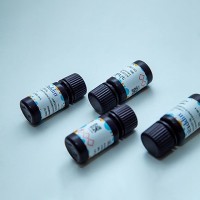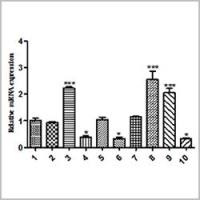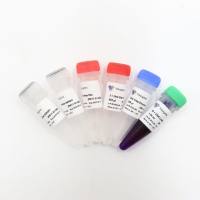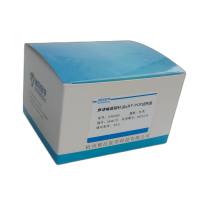【原创】real-time quantitative RT-PCR过程我这样表述可以吗?发文章用的!
丁香园论坛
1335
RNA isolation and real-time quantitative RT-PCR
Total RNA was isolated from lung, kidney and spleen issue of Smad3-/- and WT mice with TRIzol reagent (Invitrogen, Gaithersburg, MD). For first-strand cDNA synthesis, 2.5 μg total RNA were dissolved in 25 μl DEPC-treated ddH2O. Five microliters of OligdT (200 ng/μl) were added to each sample before incubation at 70°C for 10 min. Samples were cooled on ice and subjected to a mixture consisting of 5 × M-MLV RT-buffer (10 μl/sample, Promega, Madison, WI), dNTP (10
mM, 5 μl/sample), RNAsin (40 U/μl, 1 μl/sample, Promega), M-MLV RT (200 U/μl, 1
μl/sample, Promega), and DEPC-treated ddH2O (3 μl/sample). This mixture of 20 μl was
added to each RNA/OligdT solution. Samples were mixed, then 60 min at 42°C, and finally 15 min at 70°C.
Relative quantification of specific gene expression was performed by two-step real-time PCR using cDNA as a template. The amount of the PCR product was monitored by the SYBR Premix Ex TaqTM (Takara Biotechnology Company) on a Lightcycler system (Roche Molecular Biochemicals, Indianapolis, USA). The PCR mixture contained 20 μL reaction solution including 2.0 μL cDNA, 10 μL 1 × SYBR Premix Ex TaqTM and 0.2 μM of primers (0.4 μL Forward primer and Reverse primer respectively). PCR amplification was performed according to following temperature profile: 95℃ for 10s, followed by 40 cycles of 95℃ for 5 s and 60℃ for 20s, annealing and extension at 65℃ for 15 s. Data analysis was performed by the Light cycler software. All samples were amplified in triplicate from the same RNA preparation and the mean value was considered. All data were normalized by β-actin. 2-ΔΔCt method [ ]was used to calculate the expression of target genes relative to the reference gene β-actin.
The primers (Shanghai Sangon Biological Engineering Technology & Service Co., Ltd.) used in these analysis are as follows:
Total RNA was isolated from lung, kidney and spleen issue of Smad3-/- and WT mice with TRIzol reagent (Invitrogen, Gaithersburg, MD). For first-strand cDNA synthesis, 2.5 μg total RNA were dissolved in 25 μl DEPC-treated ddH2O. Five microliters of OligdT (200 ng/μl) were added to each sample before incubation at 70°C for 10 min. Samples were cooled on ice and subjected to a mixture consisting of 5 × M-MLV RT-buffer (10 μl/sample, Promega, Madison, WI), dNTP (10
mM, 5 μl/sample), RNAsin (40 U/μl, 1 μl/sample, Promega), M-MLV RT (200 U/μl, 1
μl/sample, Promega), and DEPC-treated ddH2O (3 μl/sample). This mixture of 20 μl was
added to each RNA/OligdT solution. Samples were mixed, then 60 min at 42°C, and finally 15 min at 70°C.
Relative quantification of specific gene expression was performed by two-step real-time PCR using cDNA as a template. The amount of the PCR product was monitored by the SYBR Premix Ex TaqTM (Takara Biotechnology Company) on a Lightcycler system (Roche Molecular Biochemicals, Indianapolis, USA). The PCR mixture contained 20 μL reaction solution including 2.0 μL cDNA, 10 μL 1 × SYBR Premix Ex TaqTM and 0.2 μM of primers (0.4 μL Forward primer and Reverse primer respectively). PCR amplification was performed according to following temperature profile: 95℃ for 10s, followed by 40 cycles of 95℃ for 5 s and 60℃ for 20s, annealing and extension at 65℃ for 15 s. Data analysis was performed by the Light cycler software. All samples were amplified in triplicate from the same RNA preparation and the mean value was considered. All data were normalized by β-actin. 2-ΔΔCt method [ ]was used to calculate the expression of target genes relative to the reference gene β-actin.
The primers (Shanghai Sangon Biological Engineering Technology & Service Co., Ltd.) used in these analysis are as follows:






